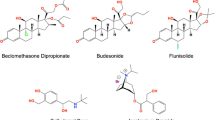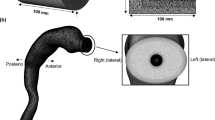Abstract
Purpose
To investigate the influence of different actuator nozzle designs on aerosol electrostatic charges and aerosol performances for pressurised metered dose inhalers (pMDIs).
Methods
Four actuator nozzle designs (flat, curved flat, cone and curved cone) were manufactured using insulating thermoplastics (PET and PTFE) and conducting metal (aluminium) materials. Aerosol electrostatic profiles of solution pMDI formulations containing propellant HFA 134a with different ethanol concentration and/or model drug beclomethasone dipropionate (BDP) were studied using a modified electrical low-pressure impactor (ELPI) for all actuator designs and materials. The mass of the deposited drug was analysed using high performance liquid chromatography (HPLC).
Results
Both curved nozzle designs for insulating PET and PTFE actuators significantly influenced aerosol electrostatics and aerosol performance compared with conducting aluminium actuator, where reversed charge polarity and higher throat deposition were observed with pMDI formulation containing BDP. Results are likely due to the changes in plume geometry caused by the curved edge nozzle designs and the bipolar charging nature of insulating materials.
Conclusions
This study demonstrated that actuator nozzle designs could significantly influence the electrostatic charges profiles and aerosol drug deposition pattern of pMDI aerosols, especially when using insulating thermoplastic materials where bipolar charging is more dominant.











Similar content being viewed by others
References
Newman SP. Principles of metered-dose inhaler design. Respir Care. 2005;50(9):1177–90.
Clark AR. Physics of aerosol formation. J Aerosol Med. 1996;9(s1):S-19–26. MDIs.
Dunbar C. Atomization mechanisms of pressurized metered dose inhaler. Part Sci Technol. 1997;15(3–4):253–71.
Sher E, Bar-Kohany T, Rashkovan A. Flash-boiling atomization. Prog Energy Combust Sci. 2008;34(4):417–39.
Kwok PCL, Glover W, Chan HK. Electrostatic charge characteristics of aerosols produced from metered dose inhalers. J Pharm Sci. 2005;94(12):2789–99. PubMed PMID: ISI:000233733300018.
Hoe S, Traini D, Chan HK, Young PM. The influence of flow rate on the aerosol deposition profile and electrostatic charge of single and combination metered dose inhalers. Pharm Res. 2009;26(12):2639–46. PubMed PMID: ISI:000271464100011.
Kwok PCL, Chan HK. Electrostatics of pharmaceutical inhalation aerosols. J Pharm Pharmacol. 2009;61(12):1587–99. PubMed PMID: ISI:000281136700002.
Diu CK, Yu CP. Deposition from charged aerosol flows through a pipe bend. J Aerosol Sci. 1980;11(4):397–402. PubMed PMID: ISI:A1980KM94500007.
Ingham DB. Precipitation of charged-particles in human airways. J Aerosol Sci. 1981;12(2):131–5. PubMed PMID: ISI:A1981LN21400005.
Thiagarajan V, Yu CP. Sedimentation from charged aerosol flows in parallel-plate and cylindrical channels. J Aerosol Sci. 1979;10(4):405–10. PubMed PMID: ISI:A1979HT24200007.
Yu CP, Chandra K. Precipitation of submicron charged-particles in human lung airways. Bull Math Biol. 1977;39(4):471–8. PubMed PMID: ISI:A1977DL62700007.
Chan TL, Yu CP. Charge effects on particle deposition in the human tracheobronchial tree. Ann Occup Hyg. 1982;26(1–4):65–75. PubMed PMID: ISI:A1982PT13100006.
Melandri C, Tarroni G, Prodi V, Dezaiacomo T, Formignani M, Lombardi CC. Deposition of charged-particles in the human airways. J Aerosol Sci. 1983;14(5):657–69. PubMed PMID: ISI:A1983RT47400008.
Tarroni G, Melandri C, Prodi V, Dezaiacomo T, Formignani M, Bassi P. An indication on the biological variability of aerosol total deposition in humans. Am Ind Hyg Assoc J. 1980;41(11):826–31. PubMed PMID: ISI:A1980KN75500008.
Ferin J, Mercer TT, Leach LJ. The effect of aerosol charge on the deposition and clearance of Tio2 particles in rats. Environ Res. 1983;31(1):148–51. PubMed PMID: ISI:A1983QR93200013.
Fraser DA. Deposition of unipolar charged particles in lungs of animals. Arch Environ Health. 1966;13(2):152. PubMed PMID: ISI:A19668080900003.
Vincent JH, Johnston WB, Jones AD, Johnston AM. Static electrification of airborne asbestos - a study of its causes, assessment and effects on deposition in the lungs of rats. Am Ind Hyg Assoc J. 1981;42(10):711–21. PubMed PMID: ISI:A1981MK58000004.
Lowell J, Rose-Innes A. Contact electrification. Adv Phys. 1980;29(6):947–1023.
McCarty LS, Whitesides GM. Electrostatic charging due to separation of ions at interfaces: contact electrification of ionic electrets. Angew Chem Int Ed. 2008;47(12):2188–207.
Greason WD. Investigation of a test methodology for triboelectrification. J Electrost. 2000;49(3):245–56.
Thomas SW, Vella SJ, Kaufman GK, Whitesides GM. Patterns of electrostatic charge and discharge in contact electrification. Angew Chem. 2008;120(35):6756–8.
Greason WD. Electrostatic discharge: a charge driven phenomenon. J Electrost. 1992;28(3):199–218.
Vinson JE, Liou JJ. Electrostatic discharge in semiconductor devices: an overview. Proc IEEE. 1998;86(2):399–420.
Castle G. Contact charging between insulators. J Electrost. 1997;40:13–20.
Lewis T. Charge transport, charge injection and breakdown in polymeric insulators. J Phys D Appl Phys. 1990;23(12):1469.
Williams MW. Triboelectric charging of insulating polymers–some new perspectives. AIP Adv. 2012;2(1):010701–9.
Fredholm O, Lovstrand K. On the discharge of static electricity from an insulator surface. J Phys E Sci Instrum. 1972;5(11):1058.
Jasti VK. Electrostatic Charge Generation and Dissipation on Woven Fabrics Treated with Antistatic and Hydrophilic Surface Finishes: North Carolina State University; 2012.
Miller HC. Flashover of insulators in vacuum: review of the phenomena and techniques to improved holdoff voltage. IEEE Trans Electr Insul. 1993;28(4):512–27.
Oda T, Ito Y. Studies on electrostatic surface discharges on corona-charged polymer surfaces. IEEE Trans Ind Appl. 1990;26(4):656–61.
Chen Y, Wong WHW, Lewis DA, Church T, Traini D, Young PM. Triboelectrification study of a pressurized metered dose inhaler (pMDI) formulation using different actuator materials and orifice designs. Respir Drug Deliv. 2012;3:845–50.
Chen Y, Traini D, Fletcher DF, Chan HK, Lewis DA, Church T, et al. The effect of pressurized metered dose inhaler (pMDI) actuator nozzle design on triboelectrification and aerosol deposition. RDD Eur. 2013;2:439–44.
Ndama AT, Guigon P, Saleh K. A reproducible test to characterise the triboelectric charging of powders during their pneumatic transport. J Electrost. 2011;69(3):146–56. PubMed PMID: ISI:000292230300002.
Gad SC. Pharmaceutical manufacturing handbook: production and processes. Hoboken: John Wiley & Sons; 2008.
Lewis D. Determination of electrical parameters of some propellants. Personal email communication to the author (ed) May 2012.
Williams III RO, Hu C. Moisture uptake and its influence on pressurized metered-dose inhalers. Pharm Dev Technol. 2000;5(2):153–62.
Chen Y, Young PM, Fletcher DF, Chan HK, Long E, Lewis D, et al. The influence of actuator materials and nozzle designs on electrostatic charge of pressurised metered dose inhaler (pMDI) formulations. Pharm Res. 2014;31(5):1325–37.
Tarjuelo J, Montero J, Carrion P, Honrubia F, Calvo M. Irrigation uniformity with medium size sprinklers. Part II: influence of wind and other factors on water distribution. Trans Am Soc Agric Eng. 1999;42(3):677–89.
Lefebvre A. Atomization and Sprays, CRC press. Arthur Lefebvre. 1988;434.
Author information
Authors and Affiliations
Corresponding author
Rights and permissions
About this article
Cite this article
Chen, Y., Young, P.M., Fletcher, D.F. et al. The Effect of Actuator Nozzle Designs on the Electrostatic Charge Generated in Pressurised Metered Dose Inhaler Aerosols. Pharm Res 32, 1237–1248 (2015). https://doi.org/10.1007/s11095-014-1529-6
Received:
Accepted:
Published:
Issue Date:
DOI: https://doi.org/10.1007/s11095-014-1529-6




